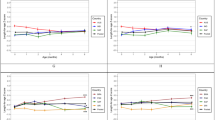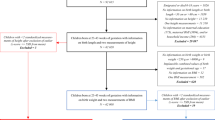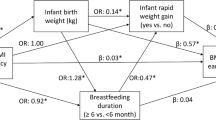Abstract
Background:
It is established that growth during early life is predictive of several health outcomes later in life, including body composition. The role of fetal vs postnatal growth remains controversial. We aimed to evaluate the effect of birth weight (BW) and newborn weight change (NWC) during the first 96 h of life on body composition during childhood, measured by: body mass (BMI), fat mass (FMI), and fat-free mass indexes (FFMI), waist circumference (WC) and waist-to-height ratio (WHtR).
Methods:
As part of the Generation XXI birth cohort, children were recruited in 2005/2006 at all public units providing obstetrical and neonatal care in Porto, Portugal. Information was collected by face-to-face interview and abstracted from clinical records. Newborn’s anthropometrics were obtained by trained examiners and NWC was estimated as (weight−BW)/BW × 100, adjusted for age in hours. At age 4 and 7, children were re-evaluated and anthropometric measurements were taken according to standard procedures. Life course data for 717 full-term singletons were presented. Path analysis was used to compute adjusted regression coefficients (β) and 95% confidence intervals.
Results:
BW had a direct effect on body composition at age 4: for each 100 g increase in BW, there was an increase of 0.043 (0.024; 0.062) on BMI, 0.037 (0.020; 0.055) on FMI, 0.024 (0.007; 0.042) on FFMI, 0.048 (0.031; 0.066) on WC, and 0.022 (0.004; 0.039) on WHtR z-scores. At age 7, BW was positively associated with body composition measures, but this effect was mediated by body composition at age 4. NWC had no effect on body composition at ages 4 or 7. Positive associations were found between body composition at ages 4 and 7.
Conclusion:
It appears that childhood body composition is programmed by fetal growth and this intra-uterine period seems more important to the development of body composition than immediate postnatal period.
This is a preview of subscription content, access via your institution
Access options
Subscribe to this journal
Receive 12 print issues and online access
$259.00 per year
only $21.58 per issue
Buy this article
- Purchase on Springer Link
- Instant access to full article PDF
Prices may be subject to local taxes which are calculated during checkout

Similar content being viewed by others
References
Lucas A . Programming by early nutrition in man. Ciba Found Symp 1991; 156: 38–50.
Barker DJ, Eriksson JG, Forsen T, Osmond C . Fetal origins of adult disease: strength of effects and biological basis. Int J Epidemiol 2002; 31: 1235–1239.
Parsons TJ, Power C, Logan S, Summerbell CD . Childhood predictors of adult obesity: a systematic review. Int J Obes Relat Metab Disord 1999; 23: S1–107.
Jaiswal M, Crume T, Vehik K, Scherzinger A, Stamm E, Hamman RF et al. Is low birth weight associated with adiposity in contemporary U.S. youth? The Exploring Perinatal Outcomes among Children (EPOCH) Study. J Dev Orig Health Dis 2012; 3: 166–172.
Wells JC, Hallal PC, Wright A, Singhal A, Victora CG . Fetal, infant and childhood growth: relationships with body composition in Brazilian boys aged 9 years. Int J Obes (Lond) 2005; 29: 1192–1198.
Rogers IS, Ness AR, Steer CD, Wells JC, Emmett PM, Reilly JR et al. Associations of size at birth and dual-energy X-ray absorptiometry measures of lean and fat mass at 9 to 10 y of age. Am J Clin Nutr 2006; 84: 739–747.
Willig AL, Hanks LJ, Fernandez JR . Birth weight is associated with body composition in a multiethnic pediatric cohort. Open Obes J 2011; 3: 4–8.
Adegboye AR, Andersen LB, Wedderkopp N, Heitmann BL . Influence of parental overweight on the association of birth weight and fat distribution later in childhood. Obes Facts 2012; 5: 784–794.
Chomtho S, Wells JC, Williams JE, Lucas A, Fewtrell MS . Associations between birth weight and later body composition: evidence from the 4-component model. Am J Clin Nutr 2008; 88: 1040–1048.
Noel-Weiss J, Courant G, Woodend AK . Physiological weight loss in the breastfed neonate: a systematic review. Open Med 2008; 2: e99–e110.
Modi N . Avoiding hypernatraemic dehydration in healthy term infants. Arch Dis Child 2007; 92: 474–475.
Oddie S, Richmond S, Coulthard M . Hypernatraemic dehydration and breast feeding: a population study. Arch Dis Child 2001; 85: 318–320.
van Dommelen P, van Wouwe JP, Breuning-Boers JM, van Buuren S, Verkerk PH . Reference chart for relative weight change to detect hypernatraemic dehydration. Arch Dis Child 2007; 92: 490–494.
Bell EF, Warburton D, Stonestreet BS, Oh W . High-volume fluid intake predisposes premature infants to necrotising enterocolitis. Lancet 1979; 2: 90.
Bell EF, Warburton D, Stonestreet BS, Oh W . Effect of fluid administration on the development of symptomatic patent ductus arteriosus and congestive heart failure in premature infants. N Engl J Med 1980; 302: 598–604.
Levene MI, Fawer CL, Lamont RF . Risk factors in the development of intraventricular haemorrhage in the preterm neonate. Arch Dis Child 1982; 57: 410–417.
Oh W, Poindexter BB, Perritt R, Lemons JA, Bauer CR, Ehrenkranz RA et al. Association between fluid intake and weight loss during the first ten days of life and risk of bronchopulmonary dysplasia in extremely low birth weight infants. J Pediatr 2005; 147: 786–790.
Wadhawan R, Oh W, Perritt R, Laptook AR, Poole K, Wright LL et al. Association between early postnatal weight loss and death or BPD in small and appropriate for gestational age extremely low-birth-weight infants. J Perinatol 2007; 27: 359–364.
Stettler N, Stallings VA, Troxel AB, Zhao J, Schinnar R, Nelson SE et al. Weight gain in the first week of life and overweight in adulthood: a cohort study of European American subjects fed infant formula. Circulation 2005; 111: 1897–1903.
Fonseca MJ, Severo M, Barros H, Santos AC . Determinants of weight changes during the first 96hours of life in full-term newborns. Birth 2014; 41: 160–168.
Larsen PS, Kamper-Jorgensen M, Adamson A, Barros H, Bonde JP, Brescianini S et al. Pregnancy and birth cohort resources in europe: a large opportunity for aetiological child health research. Paediatr Perinat Epidemiol 2013; 27: 393–414.
WHO Multicentre Growth Reference Study GroupWHO Child Growth Standards: length/height-for-age, weight-for-age, weight-for-length, weight-for-height and body mass index-for-age: Methods and development. World Health Organization: Geneva, Switzerland 2006. Report no. ISBN 92 4 154693 X.
Schaefer F, Georgi M, Zieger A, Scharer K . Usefulness of bioelectric impedance and skinfold measurements in predicting fat-free mass derived from total body potassium in children. Pediatr Res 1994; 35: 617–624.
Yuan KH, Bentler PM Three likelihood-based methods for mean and covariance structure analysis with nonnormal missing data. In: Sobel ME, Becker MP (eds). Sociological Methodology, vol. 30. 2000. pp. 165–200..
Gamborg M, Andersen PK, Baker JL, Budtz-Jorgensen E, Jorgensen T, Jensen G et al. Life course path analysis of birth weight, childhood growth, and adult systolic blood pressure. Am J Epidemiol 2009; 169: 1167–1178.
Bentler PM . Comparative fit indexes in structural models. Psychol Bull 1990; 107: 238–246.
Tucker L, Lewis C . A reliability coefficient for maximum likelihood factor analysis. Psychometrika 1973; 38: 1–10.
Steiger JH . Structural model evaluation and modification. An interval estimation approach. Multivar Behav Res 1990; 25: 173–180.
Hu L, Bentler P . Cutoff criteria for fit indices in covariance structure analysis. Conventional criteria versus new alternatives. Struct Equ Modeling 1999; 6: 1–55.
Browne MW, Cudeck C . Alternative ways of assessing model fit. Socio Meth Res 1993; 21: 230–258.
Wells JC, Chomtho S, Fewtrell MS . Programming of body composition by early growth and nutrition. Proc Nutr Soc 2007; 66: 423–434.
Wells JC . The programming effects of early growth. Early Hum Dev 2007; 83: 743–748.
Wells JC . The evolution of human fatness and susceptibility to obesity: an ethological approach. Biol Rev Camb Philos Soc 2006; 81: 183–205.
Katzmarzyk PT, Perusse L, Malina RM, Bouchard C . Seven-year stability of indicators of obesity and adipose tissue distribution in the Canadian population. Am J Clin Nutr 1999; 69: 1123–1129.
Guo SS, Chumlea WC . Tracking of body mass index in children in relation to overweight in adulthood. Am J Clin Nutr 1999; 70: 145S–148SS.
Barker DJ . The fetal and infant origins of adult disease. BMJ 1990; 301: 1111.
Curhan GC, Chertow GM, Willett WC, Spiegelman D, Colditz GA, Manson JE et al. Birth weight and adult hypertension and obesity in women. Circulation 1996; 94: 1310–1315.
Parsons TJ, Power C, Manor O . Fetal and early life growth and body mass index from birth to early adulthood in 1958 British cohort: longitudinal study. BMJ 2001; 323: 1331–1335.
Singhal A, Wells J, Cole TJ, Fewtrell M, Lucas A . Programming of lean body mass: a link between birth weight, obesity, and cardiovascular disease? Am J Clin Nutr 2003; 77: 726–730.
Andersen LG, Holst C, Michaelsen KF, Baker JL, Sorensen TI . Weight and weight gain during early infancy predict childhood obesity: a case-cohort study. Int J Obes (Lond) 2012; 36: 1306–1311.
Rolland-Cachera MF, Deheeger M, Bellisle F, Sempe M, Guilloud-Bataille M, Patois E . Adiposity rebound in children: a simple indicator for predicting obesity. Am J Clin Nutr 1984; 39: 129–135.
Taylor RW, Grant AM, Goulding A, Williams SM . Early adiposity rebound: review of papers linking this to subsequent obesity in children and adults. Curr Opin Clin Nutr Metab Care 2005; 8: 607–612.
Howe LD, Tilling K, Galobardes B, Lawlor DA . Loss to follow-up in cohort studies: bias in estimates of socioeconomic inequalities. Epidemiology 2013; 24: 1–9.
Kyle UG, Bosaeus I, De Lorenzo AD, Deurenberg P, Elia M, Gomez JM et al. Bioelectrical impedance analysis—part I: review of principles and methods. Clin Nutr 2004; 23: 1226–1243.
Nightingale CM, Rudnicka AR, Owen CG, Cook DG, Whincup PH . Patterns of body size and adiposity among UK children of South Asian, black African-Caribbean and white European origin: Child Heart And health Study in England (CHASE Study). Int J Epidemiol 2010; 40: 33–44.
Luque V, Closa-Monasterolo R, Rubio-Torrents C, Zaragoza-Jordana M, Ferre N, Gispert-Llaurado M et al. Bioimpedance in 7-year-old children: validation by dual X-ray absorptiometry - part 1: assessment of whole body composition. Ann Nutr Metab 2014; 64: 113–121.
Bioelectrical impedance analysis in body composition measurement: National Institutes of Health Technology Assessment Conference Statement. Am J Clin Nutr 1996; 64: 524S–532S.
Deurenberg P, Weststrate JA, Paymans I, van der Kooy K . Factors affecting bioelectrical impedance measurements in humans. Eur J Clin Nutr 1988; 42: 1017–1022.
Gallagher M, Walker KZ, O'Dea K . The influence of a breakfast meal on the assessment of body composition using bioelectrical impedance. Eur J Clin Nutr 1998; 52: 94–97.
Slinde F, Rossander-Hulthen L . Bioelectrical impedance: effect of 3 identical meals on diurnal impedance variation and calculation of body composition. Am J Clin Nutr 2001; 74: 474–478.
Androutsos O, Gerasimidis K, Karanikolou A, Reilly JJ, Edwards CA . Impact of eating and drinking on body composition measurements by bioelectrical impedance. J Hum Nutr Diet 2014; doi:10.1111/jhn.12259.
Acknowledgements
We gratefully acknowledge the families enrolled in Generation XXI for their kindness, all members of the research team for their enthusiasm and perseverance and the participating hospitals and their staff for their help and support. G21 was funded by Programa Operacional de Saúde—Saúde XXI, Quadro Comunitário de Apoio III and Administração Regional de Saúde Norte (Regional Department of Ministry of Health). It was supported by the Portuguese Foundation for Science and Technology (SFRH/BD/69945/2010 and FCT-PTDC/SAU-ESA/105033/2008) and by the Calouste Gulbenkian Foundation.
Author information
Authors and Affiliations
Corresponding author
Ethics declarations
Competing interests
The authors declare no conflict of interest.
Rights and permissions
About this article
Cite this article
Fonseca, M., Severo, M., Correia, S. et al. Effect of birth weight and weight change during the first 96 h of life on childhood body composition—path analysis. Int J Obes 39, 579–585 (2015). https://doi.org/10.1038/ijo.2015.11
Received:
Revised:
Accepted:
Published:
Issue Date:
DOI: https://doi.org/10.1038/ijo.2015.11
This article is cited by
-
Different levels of cardiometabolic indicators in multiple vs. singleton children
BMC Pediatrics (2019)
-
From conception to infancy — early risk factors for childhood obesity
Nature Reviews Endocrinology (2019)
-
Infant Growth and Long-term Cardiometabolic Health: a Review of Recent Findings
Current Nutrition Reports (2019)
-
Do bone mineral content and density determine fracture in children? A possible threshold for physical activity
Pediatric Research (2017)
-
Sequential Exposure to Obesogenic Factors in Females Rats: From Physiological Changes to Lipid Metabolism in Liver and Mesenteric Adipose Tissue
Scientific Reports (2017)



